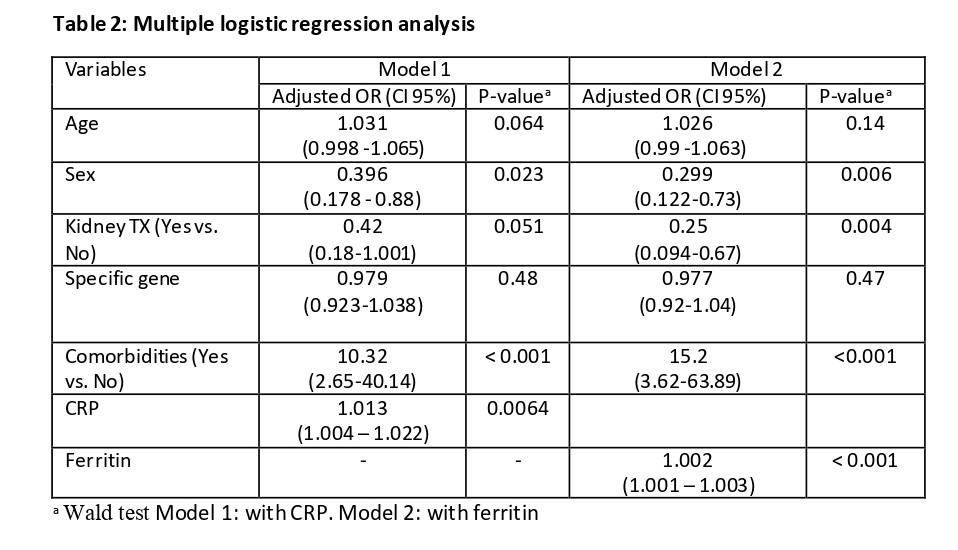Covid-19 in kidney and kidney-pancreas transplantation. Clinical utility of PCR cycle threshold
Ruben Schiavelli1, Martin Ajzenszlos3, Guillermo Martinez5, Fernando Margulis5, Galo Coronel5, Angel Carrion5, Noelia Nieva5, Marcia Pozzati2, Jessica Galeano2, Roberto Sabbatiello5, Veronica Aguirrezabala2, Ommi Acosta Sero4, Elena Maiolo3.
1Chief Of Nephrolgy and Renal transplant, Hospital General de Agudos Cosme Argerich , Caba, Argentina; 2Central Laboratory , Hospital General de Agudos Cosme Argerich , Caba, Argentina; 3Unidad de Infectología, Hospital General de Agudos Cosme Argerich , Caba, Argentina; 4División Alimentación, Hospital General de Agudos Cosme Argerich , Caba, Argentina; 5Devision of Nephrology and Renal Transplant , Hospital General de Agudos Cosme Argerich , Caba, Argentina
Introduction: COVID‑19 is diagnosed with a polymerase chain reaction (RT-PCR) test analyzing respiratory samples, with a positive or negative result. Cycle threshold (Ct) values of an RT‑PCR assay refer to the number of cycles needed to amplify viral RNA to reach a detectable level. The clinical implications of Ct values are not yet fully understood either for the general population or solid organ transplant recipients.
Objective: To describe the correlation of Ct values with the outcome of a group of transplant (TX) and immunocompetent (IC) patients (Ps).
Methods: Prospective study of TX and IC Ps diagnosed with COVID‑19 as confirmed by PCR testing between the 1st and 7th day (mean 2.85) after the onset of symptoms. The Ct of the specific gene for SARS-CoV-2 from the PCR tests was considered. A poor outcome was defined for patients with hypoxemia, mechanical ventilation or progressing to death. A logistic regression analysis, where the dependent variable was the patient’s outcome, was performed. Data were processed with the R Studio v.4.0.5 software (2021).
Results: One hundred and eighty Ps with COVID‑19 diagnosis were analyzed: 123 IC and 57 TX; 51% were women and the average age was 49±14, without differences between groups. The mean Ct level of the specific gene was 22.3 ± 6 for TX vs. 25.02 ± 7.1 for IC (p=0.009). The predominant comorbidity in the IC group was diabetes mellitus (DM) in 25%, followed by obesity in 22%, while in the TX group it was high blood pressure (HBP) in 82%, followed by DM in 19%. A significant association between comorbidities and IC was found (Chi2 = 9.34; p = 0.002). In a bivariate analysis, the specific gene and the TX and/or IC status were not associated with outcome. Age, sex, presence of comorbidities, C-reactive protein (CRP) and ferritin values were associated with outcome (Table 1). In a multiple analysis, two models were developed: one using CRP and the other ferritin as inflammatory markers. In both models, all the variables were associated with outcome, except for specific gene. The likelihood of a poor outcome increased with older age, higher ferritin and CRP levels, comorbidities, in female Ps and the IC group vs. the TX one (Table 2).
Conclusion: No association between Ct value and outcome was found. The Ct value was lower in the TX group; however, no association was found when analyzing it separately either. Comorbidities and inflammatory markers were associated with a poor outcome. The poorer outcome in the IC group could be accounted for by a higher prevalence of comorbidities and an older average age in this group.



right-click to download
